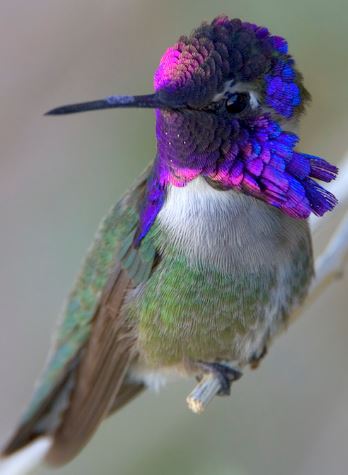Male hummingbirds do high-speed dives and use their tail feathers to sing to their females during the breeding season. For the Costa’s hummingbird, it is not the size that matters, but rather the sound.
Most hummingbirds perform their dives in front of females. Male Costa’s hummingbirds, however, dive to the side of their suitors, say researchers from the University of California, Riverside.
The researchers explained that this trajectory minimizes an audible Doppler sound that occurs when the hummingbirds dive.
Study leader, Christopher Clark, and Emily A. Mistick wrote about their study in the prestigious journal Current Biology. Clark is an assistant professor of biology at the university’s College of Natural and Agricultural studies.
Mistick is a former research assistant at the Department of Evolution, Ecology, and Organismal Biology, University of California, Riverside.
According to BIRDCAGESNOW.com, the English word ‘hummingbird’ emerged in the 17th century – so named because of the humming sound their vibrating wings make.

Hummingbirds twist their tails
The authors showed that the male aims its sound toward the female by twisting its tail. It twists its tail up by ninety degrees.
Prof. Clark had shown in previous research that the hummingbird’s tail song is made by its feathers. Specifically, the flutter of its outer tail feathers.
Prof. Clark explained:
“We don’t know why males twist only half of their tails toward the females, but it may be due to anatomical limitations that prevent them from twisting their whole tail around.”
The authors recorded Costa’s dives using an acoustic camera. They also carried out experiments in a wind tunnel. In the tunnel, they wanted to determine how the hummingbirds’ direction and speed influenced their sounds.
However, they found it hard to measure dive speed from the sound the birds produced.
Prof. Clark said:
“Once I realized it wasn’t trivial for a scientist to measure, I realized it wouldn’t be trivial for a female to measure either.”
Dynamic displays are important
The authors said that their findings add to the literature about how the males of species use athletic displays to attract mates.
Prof. Clark added:
“Most research has focused on static male attributes, such as bright colors or elongated tails, but our research shows that dynamic displays may be just as important, and males strategically control these performances to show themselves in the best possible light.”
In a Summary preceding the main article in the journal, the authors wrote:
“High-speed video of dives reveal that males twist half of their tail vertically during the dive, which acoustic-camera video shows effectively aims this sound sideways, toward the female.”/p>
” Our results demonstrate that male animals can strategically modulate female perception of dynamic aspects of athletic motor displays, such as their speed.”
Costa’s hummingbirds are fairly common in the Southwestern United States and Mexico’s Baja California Peninsula.
Hummingbirds are fascinating creatures. A team from the University of Southern Mississippi reported that the Ruby-throated hummingbird can fly 1,300 miles (2000 km) non-stop.
Video – How hummingbirds impress females
This University of California, Riverside video explains how Costa’s hummingbirds attract their females.
